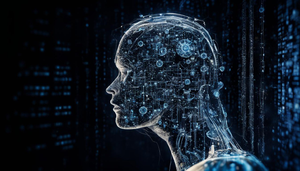Bias and Variance

- Introduction
In machine learning, understanding the concepts of bias and variance is crucial for building effective models. Bias and variance are two sources of prediction error in machine learning algorithms.
- Bias
- Definition: Bias refers to the error introduced by approximating a real-world problem, which may be complex, by a simpler model.
- Models with high bias tend to oversimplify the data and make strong assumptions about the target variable.
- High bias can lead to underfitting, where the model is too simple to capture the underlying patterns in the data.
- Common examples of high-bias models include linear regression or naive Bayes classifiers.
- Variance
- Definition: Variance pertains to the error due to sensitivity to fluctuations in the training dataset.
- Models with high variance are overly complex and adapt too much to noise in the training data.
- High variance can lead to overfitting, where the model performs well on training data but fails on unseen test data.
- Decision trees or k-nearest neighbors are examples of models that are prone to high variance.
- Balancing Bias and Variance
- The goal in machine learning is often finding a balance between bias and variance known as "bias-variance tradeoff."
- By adjusting hyperparameters like complexity or regularization strength, we can manage this tradeoff.
- Techniques for Managing Bias and Variance:
- a) Regularization:
- Helps prevent overfitting by adding a penalty term in model training based on complexity.
- Examples include L1 (Lasso) and L2 (Ridge) regularization techniques.
- b) Cross-validation:
- Allows us to estimate how well a model will generalize by splitting data into multiple subsets for training and testing.
- c) Ensemble methods:
- Combining predictions from multiple models helps reduce both bias and variance.
- Examples include Random Forests or Gradient Boosting Machines.
- d) Feature selection/engineering:
- Choosing relevant features or creating new ones can reduce noise in data leading to better generalization.
Conclusion
Understanding bias and variance is essential for building robust machine learning models that generalize well beyond just fitting the training data. Striking an optimal balance between these two factors through careful model selection, hyperparameter tuning, cross-validation, regularization, ensemble methods, and feature engineering is key for successful machine learning projects.
Overfitting
Bias and variance are two fundamental sources of error in machine learning models that play a crucial role in understanding model performance, especially concerning overfitting. Let's dive into each concept:
Bias
Bias refers to the error introduced by approximating a real-world problem, which may be complex, through an overly simplistic model. Models with high bias make strong assumptions about the data distribution and target function, disregarding important patterns or relationships within the data.
- High bias can lead to underfitting, where the model fails to capture the underlying structure of the data.
- Characteristics of high bias models:
- Simplistic: Such models may generalize too much and ignore nuances present in the data.
- High Error on Training Data: The model has difficulty capturing even the trends apparent in the training data.
Variance
Variance represents the error due to sensitivity to fluctuations in the training set. Models with high variance are highly sensitive to changes in training data and tend to perform well on training examples but poorly on unseen or test examples.
- High variance often results from excessively complex models that fit noise instead of true patterns in data.
- Characteristics of high variance models:
- Overly Complex: These models have too many degrees of freedom relative to available data points.
- Low Generalization: While they excel at fitting training examples, they struggle with new, unseen instances.
Overfitting
Overfitting occurs when a model learns both true patterns present in training data as well as noise. This phenomenon is primarily driven by high variance; however, it can also result from insufficient regularization techniques applied during model training.
- Effects of overfitting:
- Reduced generalization capability leading to poor performance on unseen or test datasets.
- Memorization rather than learning: The model memorizes specific examples without grasping underlying concepts.
To combat overfitting, achieving an optimal balance between bias and variance is crucial while developing machine learning models. Techniques such as cross-validation, regularization methods (e.g., L1/L2 regularization), early stopping, and ensemble methods (e.g., bagging) are commonly used strategies for mitigating these issues.
Underfitting
- Introduction
- In machine learning, understanding the concepts of bias and variance is essential to diagnose the performance of a model.
- The balance between bias and variance plays a crucial role in determining the model's ability to generalize well on unseen data.
- Bias
- Bias refers to the error introduced by approximating a real-world problem, which may be very complex, by a simple model.
- A high bias model makes strong assumptions about the underlying data distribution, leading to oversimplified models that underfit the data.
- Variance
- Variance measures how much predictions for a given point vary between different realizations of the model.
- High variance models are overly sensitive to fluctuations in the training set, capturing noise along with true patterns and leading to overfitting.
- Underfitting
- Underfitting occurs when our model is too simple to capture the underlying structure of the data.
Causes of Underfitting:
- Insufficient complexity in your model (high bias)
- Inadequate features or input variables
- Small amount of training data
How to Address Underfitting:
- Increase model complexity (e.g., add more layers or neurons in neural networks).
- Add additional features or interactions between features.
- Collect more relevant and diverse training data.
In conclusion, understanding bias and variance is crucial for diagnosing issues such as underfitting. By finding an optimal balance between these two factors, we can improve our models' performance and generalization capabilities on unseen data.
Regularization
In the field of machine learning, managing bias and variance is essential for building accurate models. Bias refers to the error introduced by approximating a real-world problem, usually due to overly simplistic assumptions made by the model. On the other hand, variance arises from the model's sensitivity to fluctuations in the training dataset.
The Bias-Variance Tradeoff
The bias-variance tradeoff is a fundamental concept in machine learning that involves balancing these two sources of error. A high-bias model tends to underfit the data, while a high-variance model tends to overfit it.
Regularization Techniques
Regularization methods are used to address issues related to bias and variance in machine learning models:
- L1 (Lasso) and L2 (Ridge) Regularization:
- These techniques add penalty terms to the cost function based on either the absolute values of coefficients (L1) or squared values of coefficients (L2).
- Elastic Net Regularization:
- Combines L1 and L2 regularization techniques by adding both penalties to the cost function with separate alpha parameters.
- Dropout:
- Commonly used in neural networks, dropout randomly sets a fraction of input units to zero during each update, which helps prevent overfitting.
- Batch Normalization:
- Normalizes input layers by adjusting and scaling activations, which can improve generalization capabilities.
- Early Stopping:
- Stops training once validation error starts increasing after reaching a minimum point, preventing further overfitting.
By employing appropriate regularization techniques, machine learning practitioners can fine-tune their models' complexity levels effectively.
















